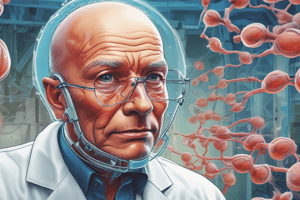Podcast
Questions and Answers
What is the approximate percentage of collagen IV in Matrigel?
What is the approximate percentage of collagen IV in Matrigel?
- 50%
- 20%
- 30% (correct)
- 40%
What is the main purpose of 3D bioprinting?
What is the main purpose of 3D bioprinting?
- To create prosthetic limbs
- To construct living, functional organs for reconstructive medicine (correct)
- To create artificial organs for transplantation
- To develop new biomaterials
What is used to obtain a 3D image of the organ to be printed?
What is used to obtain a 3D image of the organ to be printed?
- X-rays
- Magnetic Resonance Imaging (MRI) scans (correct)
- Computed Tomography (CT) scans
- Ultrasound
What is the major flaw of the top-down printing approach?
What is the major flaw of the top-down printing approach?
What is the term for the process of removing cells from an organ/tissue leaving the extracellular matrix scaffold of the original organ/tissue?
What is the term for the process of removing cells from an organ/tissue leaving the extracellular matrix scaffold of the original organ/tissue?
What is the purpose of the bioink composition in 3D bioprinting?
What is the purpose of the bioink composition in 3D bioprinting?
What is the advantage of bottom-up printing over top-down printing?
What is the advantage of bottom-up printing over top-down printing?
What is the composition of Matrigel in terms of laminin and entactin?
What is the composition of Matrigel in terms of laminin and entactin?
What is the final step in the 3D bioprinting process?
What is the final step in the 3D bioprinting process?
Flashcards are hidden until you start studying
Study Notes
Stem Cells and Gene Therapy
- Hematopoietic stem cells (HSCs) are used for gene therapy in adults and children.
- HSCs are readily accessible from the patient's bone marrow, reducing the risk of immune rejection upon reintroduction.
- They exhibit rapid in vitro replication, longevity, and have the capacity to differentiate into both red and white blood cells.
Induced Pluripotent Stem Cells (iPSC)
- The basic concept of iPSC is to use genes involved in cell development to push a somatic cell back to an earlier stage of pluripotency.
- The first trail to make iPSC involved using retroviruses to deliver four transgenes (OCT3/4, SOX2, c-MYC, and KLF4) into fibroblasts.
- Expression of these four genes, which encode transcription factors involved in cell development, “reprograms” the fibroblasts back to an earlier stage of differentiation.
The Role of the Four Transgenes
- c-MYC is not essential for cell reprogramming, but increases the process efficiency by increasing the proliferation rate.
- KLF4 increases the p21 protein levels, decreasing the proliferation rates and p53 levels, thereby reducing apoptosis risk.
- SOX-2 regulates phenotypic maintenance of stem cells at the mitosis M-G1 transition.
- OCT4 represses genes related to cell differentiation, preserving cell pluripotency.
Organoids
- Organoids are three-dimensional (3D) cellular clusters that self-organize themselves into structures that resemble mini-organs and exhibit similar organ functionality and architecture.
- Organoids can be composed from pluripotent stem cells or adult stem cells.
- Organ-specific biochemical cues and morphogens (Fibroblast Growth Factor, Wnt, Sonic Hedgehog) are used to control several signaling pathways involved in the proliferation, migration, and differentiation of stem cells.
Supporting Matrix
- Laminin, fibronectin, collagen, and Matrigel are examples of physical supportive matrix components used in organoids.
- Matrigel is a commercially available cell culture product obtained from reconstituted basement membrane extracted from Engelbreth-Holm-Swarm mouse sarcoma.
- Supporting matrix is also available from decellularized matrices, biomaterial customization, and nanoparticles.
3D Bioprinting
- 3D bioprinting aims to construct living, functional organs for reconstructive medicine by printing living cells and matrices in a 3D structure that resembles the shape of the organ to be generated.
- The 3D bioprinting process comprises: obtaining a 3D image of the organ to be printed, selecting the bioink composition, and the actual printing procedure, culturing, and finally the organ quality control.
Combining Cells with Biomaterials
- Combining cells with biomaterials can be done through top-down printing or bottom-up printing.
- Top-down printing disperses cells homogeneously into biomaterials and shapes them to resemble the desired organ.
- Bottom-up printing constructs the organ layer by layer, using different types of bioinks in parallel, with different types of cells, hydrogels, and soluble compounds.
Studying That Suits You
Use AI to generate personalized quizzes and flashcards to suit your learning preferences.




